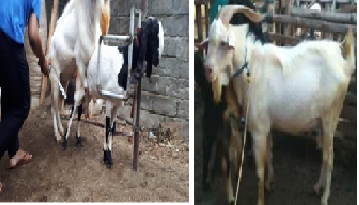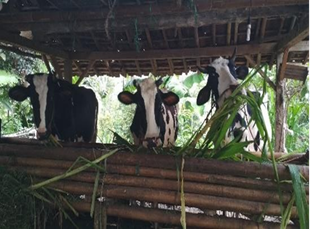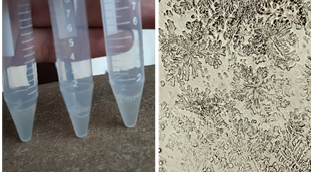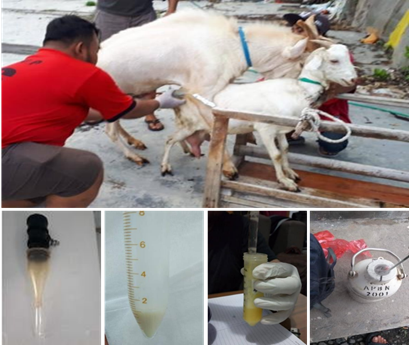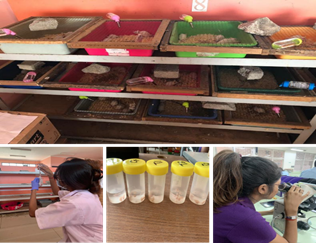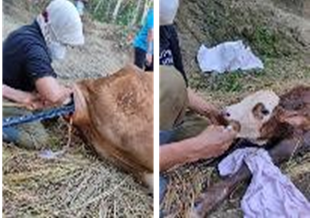Synergistic protective effects of α-tocopherol and zinc sulfate on superoxide dismutase activity and p53 expression in ovarian granulosa cells of lead-exposed female Wistar rats (Rattus norvegicus)
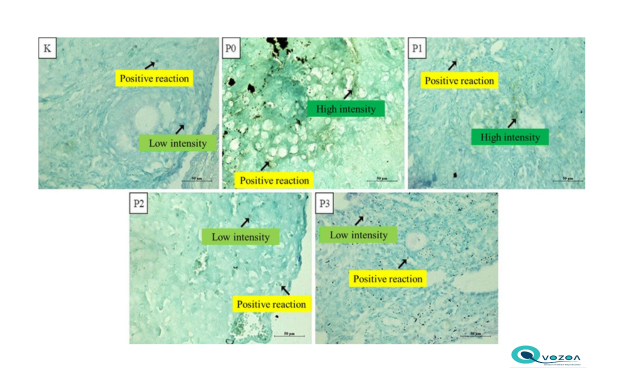
Downloads
This study aimed to evaluate the protective effects of α-tocopherol and zinc sulfate on oxidative stress parameters in ovarian granulosa cells of female Wistar rats (Rattus norvegicus) exposed to lead acetate (Pb(C₂H₃O₂)₂). A total of 25 rats were randomly divided into five groups: Control (C), lead exposure only (T0), α-tocopherol + lead (T1), zinc sulfate + lead (T2), and α-tocopherol + zinc sulfate + lead (T3). Treatments were administered orally for 21 days. Superoxide dismutase (SOD) levels were measured spectrophotometrically, and p53 expression was analyzed using immunohistochemistry. The results showed that SOD levels significantly decreased in group T0 compared to the control (p <0.05), while treatment with either α-tocopherol (T1), zinc sulfate (T2), or their combination (T3) significantly improved SOD levels compared to T0. Moreover, p53 expression was markedly elevated in T0, indicating enhanced oxidative stress and potential apoptosis, whereas all antioxidant-treated groups showed reduced p53 expression, with T3 demonstrating values comparable to the control group. In conclusion, the combination of α-tocopherol and zinc sulfate provided a synergistic antioxidant effect, effectively enhancing SOD levels and suppressing p53 expression in granulosa cells of lead-exposed rats. This suggested a promising therapeutic potential of these compounds in mitigating lead-induced ovarian toxicity.
Ansar S, Farhat S, Albati AA, Abudawood M, Hamed S. 2019. Effect of curcumin and curcumin nanoparticles against lead induced nephrotoxicity. Biomed Res. 30: 57-60.
Beredugo S, Ilegbedion IG, Tabowei W, Uchuno GA. 2022. Assessment of the therapeutic potentials of selenium and vitamin E on ovarian and renal tissues of lead exposed rats. Int J Recent Innov Med Clin Res. 4: 1-9.
Cangelosi V, Ruckthong L, Pecoraro VL. 2017. Lead(II) binding in natural and artificial proteins. Met Ions Life Sci. 10: 17.
Collin MS, Venkatraman SK, Vijayakumar N, Kanimozhi V, Arbaaz SM, Stacey RGS, Anusha J, Choudhary R, Lvov V, Tovar GI, Senatov F, Koppala S, Swamiappan S. 2022. Bioaccumulation of lead (Pb) and its effects on human: A review. J Hazard Mater Adv. 7: 100094.
Dumitrescu E, Chiurciu V, Muselin F, Popescu R, Brezovan D, Cristina RT. 2015. Effects of long-term exposure of female rats to low levels of lead: Ovary and uterus histological architecture changes. Turk J Biol. 39: 284-9.
Erdemli ME, Erdemli Z, Turkoz Y, Bag HG, Selamoglu Z. 2019. The effects of acrylamide and vitamin E administration during pregnancy on adults’ ovarian tissue: An experimental study. Ann Med Res. 26: 1857.
Fedchenko N, Reifenrath J. 2014. Different approaches for interpretation and reporting of immunohistochemistry analysis results in the bone tissue - a review. Diagn Pathol. 9: 221.
Formigari A, Gregianin E, Irato P. 2013. The effect of zinc and the role of p53 in copper-induced cellular stress responses. J Appl Toxicol. 33: 527-36.
Garner TB, Hester JM, Carothers A, Diaz FJ. 2021. Role of zinc in female reproduction. Biol Reprod. 104: 976-94.
Hamed E, Sayyed H, Galal H. 2014. The effect of vitamin E on lead induced gonadal dysfunctions in adult Wistar Albino rats. Bull Egypt Soc Physiol Sci. 34: 220-36.
Jena AB, Samal RR, Bhol NK, Duttaroy AK. 2023. Cellular red-ox system in health and disease: The latest update, Biomed Pharmacother. 162: 114606.
Jomova K, Raptova R, Alomar SY, Alwasel SH, Nepovimova E, Kuca K, Valko M. 2023. Reactive oxygen species, toxicity, oxidative stress, and antioxidants: chronic diseases and aging. Arch Toxicol. 97: 2499-574.
Kumar S. 2018. Occupational and environmental exposure to lead and reproductive health impairment: An overview. Indian J Occup Environ Med. 22: 128-37.
Lebold KM, Traber MG. 2014. Interactions between α-tocopherol, polyunsaturated fatty acids, and lipoxygenases during embryogenesis. Free Radic Biol Med. 66: 13-9.
Lobo V, Patil A, Phatak A, Chandra N. 2010. Free radicals, antioxidants and functional foods: Impact on human health. Pharmacogn Rev. 4: 118-26.
Marreiro DD, Cruz KJ, Morais JB, Beserra JB, Severo JS, de Oliveira AR. 2017. Zinc and oxidative stress: Current mechanisms. Antioxidants (Basel) 6: 24.
Nasiadek M, Stragierowicz J, Klimczak M, Kilanowicz A. 2020. The role of zinc in selected female reproductive system disorders. Nutrients 12: 2464.
Osowski A, Fedoniuk L, Bilyk Y, Fedchyshyn O, Sas M, Kramar S, Lomakina Y, Fik V, Chorniy S, Wojtkiewicz J. 2023. Lead exposure assessment and its impact on the structural organization and morphological peculiarities of rat ovaries. Toxics 11: 769.
Prasad AS, Bao B. 2019. Molecular mechanisms of zinc as a pro-antioxidant mediator: Clinical therapeutic implications. Antioxidants (Basel) 8: 164.
Pruteanu LL, Bailey DS, Grădinaru AC, Jäntschi L. 2023. The biochemistry and effectiveness of antioxidants in food, fruits, and marine algae. Antioxidants (Basel) 12: 860.
Saleh HS, Omar E, Froemming GR, Said RM. 2015. Tocotrienol preserves ovarian function in cyclophosphamide therapy. Hum Exp Toxicol. 34: 946-52.
Salundik S, Suryahadi S, Mansjoer SS, Sopandie D, Ridwan W. 2012. Heavy metals Pb and As in fresh milk from cows fed by in different roughages Kebon Pedes Bogor Dairy Cattle. Indonesian Journal of Animal Science. 14: 308-318.
Shalan MG. 2024. Mitigating lead acetate-induced histopathologic and physiologic disorders in rats receiving vitamin C and glutathione supplement. Heliyon 11: e41256.
Uchewa OO, Ezugworie OJ. 2019. Countering the effects of lead as an environmental toxicant on the microanatomy of female reproductive system of adult wistar rats using aqueous extract of Ficus vogelii. J Trace Elem Med Biol. 52: 192-8.
Virgolini MB, Aschner M. 2021. Molecular mechanisms of lead neurotoxicity. Adv Neurotoxicol. 5: 159-213.
WHO. 2022. Lead poisoning and health. 1–4.
Wurlina W, Mustofa I, Meles DK, Safitri E, Susilowati S, Mulyati S, Utomo B, Utama S. 2022. α-Tocopherol restores semen quality in rats exposed to 2,3,7,8-tetrachlorodibenzo-p-dioxin. Vet World 15: 316-23.
Xu J, Lian LJ, Wu C, Wang XF, Fu WY, Xu LH. 2008. Lead induces oxidative stress, DNA damage and alteration of p53, Bax and Bcl-2 expressions in mice. Food Chem Toxicol. 46: 1488-94.
Copyright (c) 2025 iqbal dwi warsito, Suherni Susilowati, Erma Safitri, Ragil Angga Prastiya, Maya Nurwartanti Yunita, Amung Logam Saputro

This work is licensed under a Creative Commons Attribution-ShareAlike 4.0 International License.
Ovozoa by Unair is licensed under a Creative Commons Attribution-ShareAlike 4.0 International License.
1. The journal allows the author to hold the copyright of the article without restrictions.
2. The journal allows the author(s) to retain publishing rights without restrictions
3. The legal formal aspect of journal publication accessibility refers to Creative Commons Attribution Share-Alike (CC BY-SA).
4. The Creative Commons Attribution Share-Alike (CC BY-SA) license allows re-distribution and re-use of a licensed work on the conditions that the creator is appropriately credited and that any derivative work is made available under "the same, similar or a compatible license”. Other than the conditions mentioned above, the editorial board is not responsible for copyright violation.





























